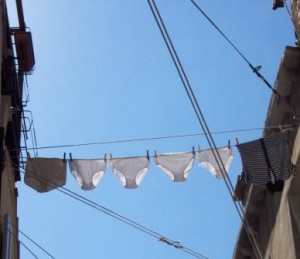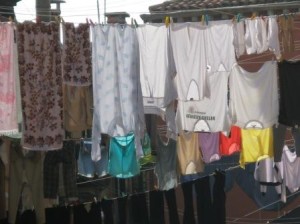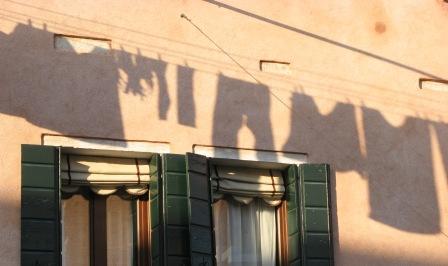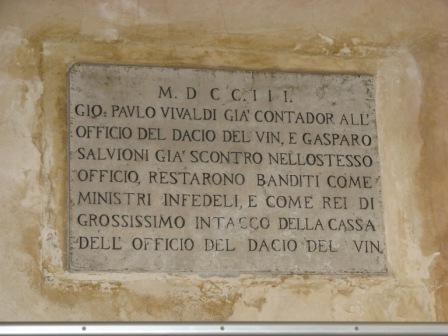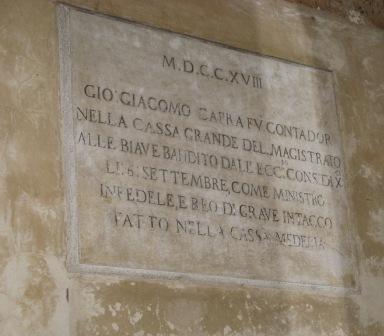Like the rest of the city, the long promenade along the lagoon from the Arsenal to the Giardini (public gardens) has experienced assorted mutations over the centuries.
This stretch of waterfront, some 100 years ago or more, was a tiny industrial landscape lined with boatyards sloping down muddy inclines into the water. Did I say “boats”? I also meant “ships.” This was a serious place where serious, unglamorous, important work got done.
But by the Thirties the boatyards were mostly moribund, and in 1937 they were demolished to make way for this corniche which was dubbed the “Riva dell’ Impero,” or “riva of the empire.” That would have been the one Mussolini intended to refound along the lines of the earlier Roman version.
But after the episode of August 3, 1944, the name was changed to the Riva dei Sette Martiri (the riva of the seven martyrs).
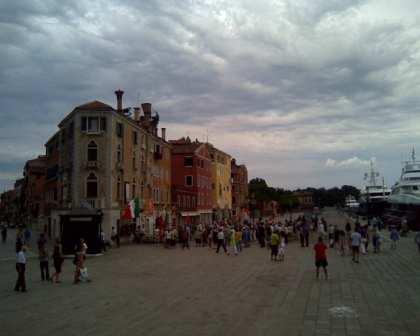
It happened like this: The final phases of World War II in Venice were very tense, marked by an increasing number of events involving partisan resistance and reprisals. In this case, we skip almost immediately to the reprisal stage.
The Cronaca di Venezia recounted the story on July 1, 1945, on the eve of the first anniversary of the event in question. As with any story involving the word “martyr,” it’s not one that will make you smile.
Here is a transcript of the story, published in the Gazzettino a few years ago, translated by me:
“At dawn on 3 August 1944, a group of houses which extend from the beginning of the then-Riva dell’Impero to the limits of the Giardini was assaulted by the German soldiers. All of the inhabitants had to leap out of bed and let themselves be searched, mutely witnessing, astonished, the fanatical search for arms. Everything was thrown in the air, trampled, and often, in their rage, destroyed.
“Amazed, everyone asked themselves what could have happened, the reason for such a furor. They came to know later that that night [i.e., the night of August 1], the crew of a German torpedo ship moored at the Riva had abandoned themselves to an orgy and that the German sentinel had been offered, many times, wines and liquors. People overheard ‘evviva’ and other toasts exchanged between the crew and the sentinel.
“A few days later, it became known that the sentinel, drunk, had fallen in the water, and had been pulled out, and that no traces of any firearm or any other sign that could prove the cause of his death could be found on his body.
“But it was too late. The firing squad and the revenge had already taken place.
“That morning, 500 men of the neighborhood, after having been compelled to stand immobile for more than two hours on the riva with their faces against the walls of the houses along the left side of the via Garibaldi, were taken to the riva and made to watch the execution of seven hostages who had been taken from the prison of Santa Maria Maggiore.
“A little before the massacre, the Germans had erected two poles on the riva, between which a rope had been strung.
“The scaffold is ready. A motor launch from the prison arrives with the seven victims: Bruno Degasperi, 20; the brothers Alfredo and Luciano Gelmi, respectively 20 and 28, all from Trento; Girolamo Guasto, 20, from Agrigento; Aliprando Armellin, 23, from Vercelli but residing in Mestre; Alfredo Viviani, 36, born and living in Venice; Gino Conti, 46, from Cavarzere.
“The prison chaplain, mons. D’Andrea, hears their confessions and administers Communion. The butcher [executioner] offers them all a cigarette, which they accept. The few minutes which pass between lighting them and their disappearance seems eternal. How many people lining the riva or immobile at the windows are observing with terror the tragic scene.
“Now the seven unhappy ones are tied, with arms extended as if on a cross, to the rope stretched between the two poles. Their backs are toward the Lagoon. The sentence of death is read.
“A German official turns toward the 500 selected citizens and reads, in Italian: ‘During the night between August 1 and 2, by the hand of someone unknown, a sentinel of the German navy was assassinated during the fulfillment of his duty. The German Command has determined to apply the reprisal of war, for which in your presence these seven persons will be shot, guilty of terroristic acts; after which we will take from among you 150 hostages whose fate will depend on the outcome of the current inquest.’
“The chaplain extends the crucifix to each of the seven victims to kiss and the 24 rifles are aimed at their chests. Behind the firing squad the chaplain holds up the crucifix, on which the eyes of those who are about to die are fixed — and who give their last desperate cry, ‘Avenge us!’ A German officer raises his hand and then lets it fall, shouting ‘Fire!’
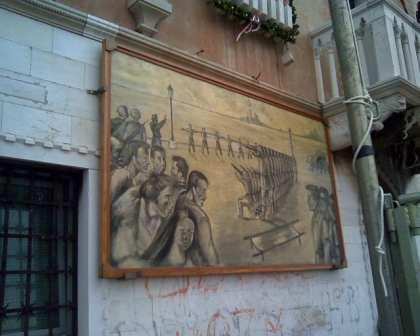
“The thunderous volley strikes even the rope itself, which breaks, leaving the poor bodies to fall heavily to the ground. A shot from the pistol to each temple, a few other shots to those who are in agony.
“The sacrifice is complete. In the light of the rising sun not even the echo of their last desperate appeal remains. The pavement of the riva is strewn with large bloodstains. All eyes are fixed on those vermilion stains, and from every heart arises a vow of revenge.
“The bodies of the Martyrs are placed on a boat and taken to the cemetery.
“To remove the clots of blood, teeth, and brain matter from the pavement, the Germans give brooms and buckets of water to the innocent children of the neighborhood.
“Then the selection is made from the 500 men and about 150 hostages are taken to the prison to await the results of the inquest.”
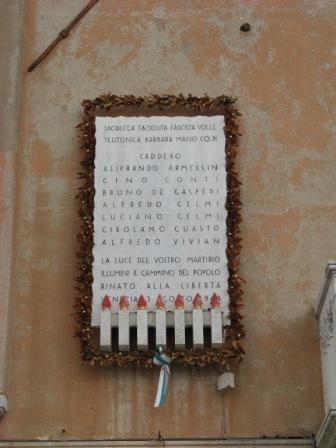
Later, they put up a very nice stone tablet, with seven symbolic electric candles, one for each sacrificial lamb, which are never illuminated. It’s true that they were unjustly condemned, but one also remembers that if they were in prison it’s possible that they were not, as they say here, the “shinbone of a saint.” Perhaps they were guilty of political crimes, or of homicide, or of resistance (which would cover both of the preceding misdemeanors).
But they definitely were not involved in the murder of any drunken German sentinel, and forming a cleanup squad of children has to be just about the worst thing in this entire appalling story. But then again, it wouldn’t be war without stupidity and death. It would just be another day in the most beautiful city in the world.
Now it’s today. Every year, on the anniversary of this event, the local Communist Party club organizes a commemorative ceremony. At six o’clock this evening they formed up their procession, and walked first to the monument outside the Giardini to the monument to the partisans to render homage.
Then they walked up the Riva dei Sette Martiri to the plaque and placed the large laurel wreath, and two large arrangements of scarlet roses, beneath it. There were banners, there were speeches.
A small mismatched group of onlookers/participants/curious bystanders watched and listened, and was photographed by various people, including me. (I apologize for the quality, I snapped these with my cell phone.)
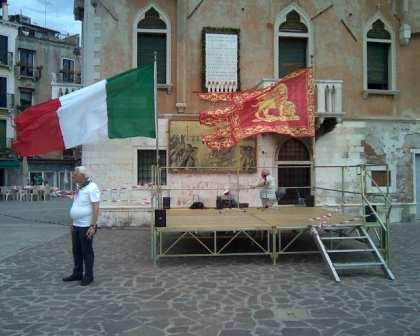
I turned around to look at the audience and there was a mountain of ship steaming ponderously past: the aptly named Costa Fortuna. I mean “aptly” considering the caliber of fortune which the seven martyrs (and the German sentinel, and the children) had been 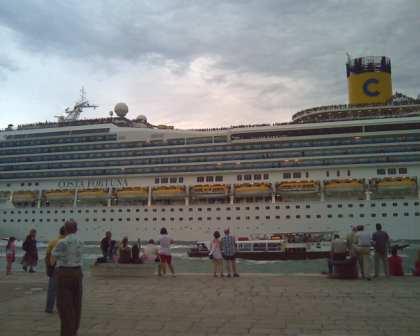
When thoughts like that begin to merge in my brain, it’s time to leave. So I headed down via Garibaldi toward home, just as the first gust of cold air hit my back. The wind had been rising all afternoon, but when I felt the temperature plunge suddenly I knew it was time to get going.
Ten minutes later I was inside, and it was raining hard outside. And that was undoubtedly the end of the Martyrs’ Moment until next year. I’m sorry it didn’t end better. But then again, it was also raining on the Costa cruise which at that point wasn’t even out of sight of land.
Speaking of martyrs and resistance and all, we were walking across the central piazza in Mestre this morning, the Piazza Erminio Ferretto. I casually asked Lino who Ferretto was, and he said, “He was a partisan in the Second World War. He was my sister-in-law’s brother.”
Excuse me? Yes, his oldest brother had married a girl from Gazzera, a town outside Mestre, by the name of Elvira Ferretto. Her brother was a full-bore freedom fighter who had spent part of the Thirties also fighting against Franco in Spain. He and his companions got caught by a Fascist patrol one night — they were hiding in a manger and got jabbed by the pitchforks the soldiers punched into the hay, testing to see if there was anybody under there.
I wonder if it’s good to dwell on these things or not. I’m thinking maybe not.

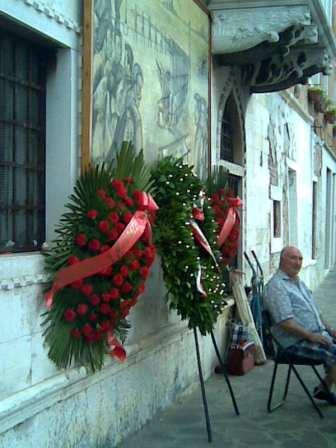
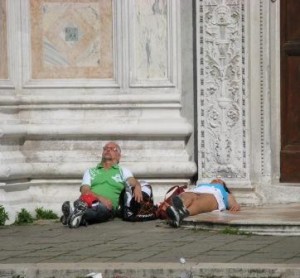
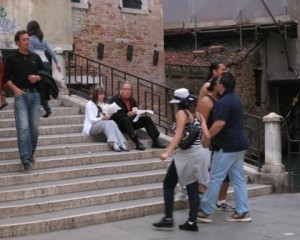
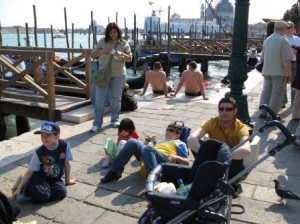
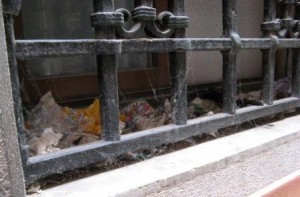
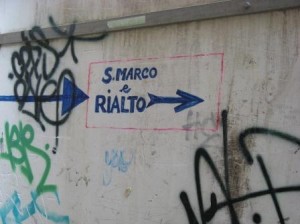 Street vendors — insistent and vaguely disturbing. Which leads to Point Two.
Street vendors — insistent and vaguely disturbing. Which leads to Point Two.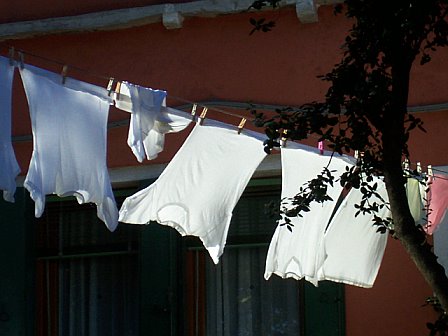 Clotheslines, fluttering with their victorious domestic banners, are like daily bulletins, footnotes in the ongoing family story. Plenty of people walk around Venice snapping pictures of laundry, I suppose because by now it’s something you don’t see very often back home. I can tell you that when I see people photographing my laundry, it annoys me. I don’t regard it or myself as either quaint or picturesque.
Clotheslines, fluttering with their victorious domestic banners, are like daily bulletins, footnotes in the ongoing family story. Plenty of people walk around Venice snapping pictures of laundry, I suppose because by now it’s something you don’t see very often back home. I can tell you that when I see people photographing my laundry, it annoys me. I don’t regard it or myself as either quaint or picturesque. This week is a case in point. We have been having a stretch of dream weather: breezy, sunny, dry, cloudless. It’s weather which inspires rational people — and there are more of them than I imagined, judging by the troop transports which are the overloaded vaporettos heading to the Lido — as I say, rational people to obey the seductive call, “Beeeeeeeeeaaaaaaaach.”
This week is a case in point. We have been having a stretch of dream weather: breezy, sunny, dry, cloudless. It’s weather which inspires rational people — and there are more of them than I imagined, judging by the troop transports which are the overloaded vaporettos heading to the Lido — as I say, rational people to obey the seductive call, “Beeeeeeeeeaaaaaaaach.”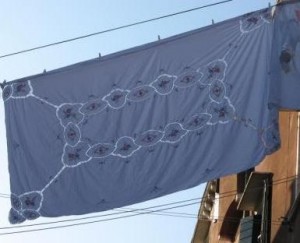 If you have ever tried to dry anything on a winter day of chilly fog, or even those few days when it’s so cold your underwear literally freezes solid (I did not make that up), you don’t need to be reading this, because you know. Also, I think laundry is beautiful.
If you have ever tried to dry anything on a winter day of chilly fog, or even those few days when it’s so cold your underwear literally freezes solid (I did not make that up), you don’t need to be reading this, because you know. Also, I think laundry is beautiful. 
